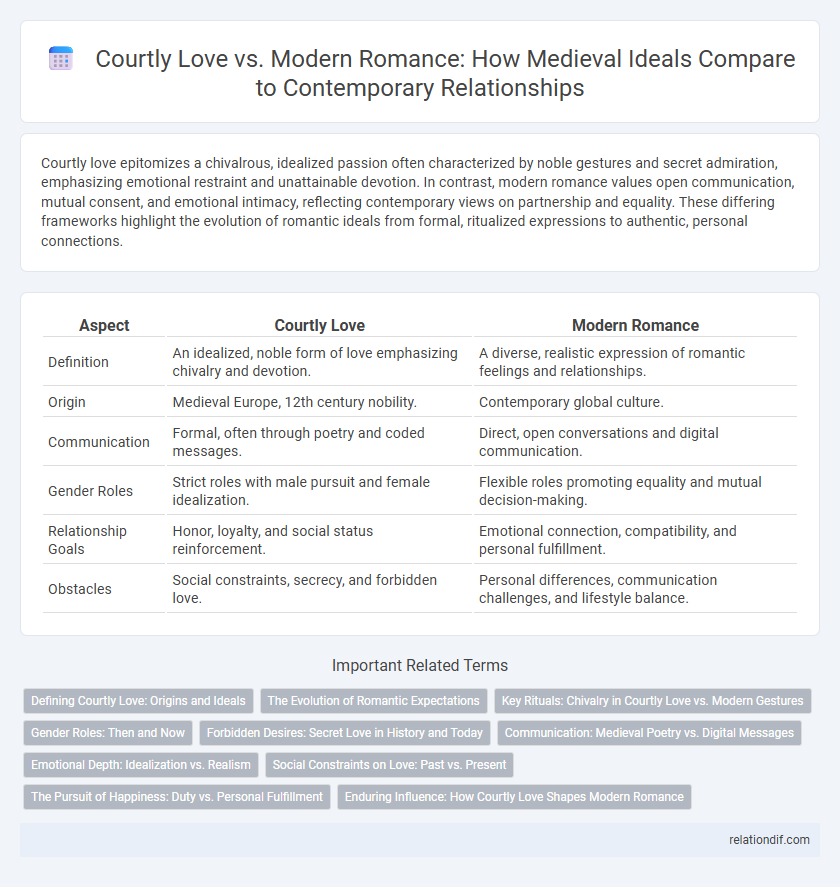Courtly love epitomizes a chivalrous, idealized passion often characterized by noble gestures and secret admiration, emphasizing emotional restraint and unattainable devotion. In contrast, modern romance values open communication, mutual consent, and emotional intimacy, reflecting contemporary views on partnership and equality. These differing frameworks highlight the evolution of romantic ideals from formal, ritualized expressions to authentic, personal connections.
Table of Comparison
| Aspect | Courtly Love | Modern Romance |
|---|---|---|
| Definition | An idealized, noble form of love emphasizing chivalry and devotion. | A diverse, realistic expression of romantic feelings and relationships. |
| Origin | Medieval Europe, 12th century nobility. | Contemporary global culture. |
| Communication | Formal, often through poetry and coded messages. | Direct, open conversations and digital communication. |
| Gender Roles | Strict roles with male pursuit and female idealization. | Flexible roles promoting equality and mutual decision-making. |
| Relationship Goals | Honor, loyalty, and social status reinforcement. | Emotional connection, compatibility, and personal fulfillment. |
| Obstacles | Social constraints, secrecy, and forbidden love. | Personal differences, communication challenges, and lifestyle balance. |
Defining Courtly Love: Origins and Ideals
Courtly love originated in the medieval European aristocracy, embodying ideals of chivalry, secrecy, and noble devotion often directed toward unattainable or married women. This practice emphasized ritualized expressions of admiration and service, distinguishing itself from both arranged marriages and purely physical attraction. Modern romance, by contrast, prioritizes emotional intimacy, mutual consent, and egalitarian partnership, reflecting contemporary values of personal choice and individual fulfillment.
The Evolution of Romantic Expectations
Courtly love, rooted in medieval chivalry, emphasized idealized, often unattainable affection marked by ritualized gestures and social decorum, contrasting sharply with modern romance that values emotional authenticity, mutual consent, and personal fulfillment. Expectations in courtly love centered on devotion from afar and noble sacrifice, whereas contemporary romance prioritizes open communication, equality, and individual happiness. This evolution reflects broader societal changes in gender roles, personal identity, and cultural norms surrounding love and relationships.
Key Rituals: Chivalry in Courtly Love vs. Modern Gestures
Courtly love rituals emphasized chivalric acts such as knights performing noble deeds, offering symbolic tokens, and engaging in poetic praise to demonstrate devotion. Modern romance favors everyday gestures like thoughtful communication, shared experiences, and personalized gifts that reflect emotional intimacy. While courtly love centered on idealized, often unrequited admiration, contemporary romance prioritizes mutual affection and practical expressions of care.
Gender Roles: Then and Now
Courtly love in medieval times emphasized chivalric ideals where men pursued women with unwavering devotion, reinforcing rigid gender roles of noble knights and passive ladies. Modern romance challenges these traditional norms, promoting equality and mutual respect regardless of gender, allowing both partners to express vulnerability and agency. Shifting perceptions of gender roles reflect broader social changes towards inclusivity and emotional authenticity in contemporary relationships.
Forbidden Desires: Secret Love in History and Today
Courtly love, characterized by chivalric devotion and idealized, often unattainable affection, contrasts with modern romance that embraces openness and emotional authenticity. Forbidden desires in history were cloaked in secrecy due to rigid social hierarchies, whereas contemporary secret love navigates complexities of personal freedom and societal norms. The evolution from coded expressions of passion to candid emotional experiences highlights the enduring tension between societal restrictions and individual longing.
Communication: Medieval Poetry vs. Digital Messages
Medieval poetry in courtly love emphasized elaborate, symbolic language to express unspoken desires and social boundaries, fostering a sense of mystery and reverence. Modern romance relies on digital messages that prioritize immediacy and emotional transparency, often using emojis and abbreviations to convey feelings quickly. The evolution from poetic allegory to instant communication reshapes how intimacy and affection are articulated across cultures.
Emotional Depth: Idealization vs. Realism
Courtly love often idealized the beloved as a perfect, almost unattainable figure, emphasizing lofty emotions and chivalric devotion that transcended physical presence. Modern romance prioritizes emotional realism, exploring complex, authentic feelings and the imperfections of relationships. This shift highlights personal growth and mutual understanding over idealized admiration.
Social Constraints on Love: Past vs. Present
Courtly love in medieval society was heavily shaped by strict social hierarchies and rigid class distinctions, often requiring secrecy and unattainability as key elements. Modern romance, contrastingly, embraces individual choice and emotional authenticity, with fewer societal restrictions on partner selection and expressions of love. The shift from external social constraints to personal autonomy reflects evolving cultural values surrounding relationships and intimacy.
The Pursuit of Happiness: Duty vs. Personal Fulfillment
Courtly love emphasized duty, honor, and social hierarchy, often requiring lovers to suppress personal desires in favor of chivalric obligations and societal expectations. Modern romance prioritizes personal fulfillment and emotional happiness, encouraging individuals to pursue relationships based on mutual affection and self-expression. The shift from duty-bound courtship to passion-driven partnerships reflects broader cultural changes toward individualism and personal well-being in contemporary love.
Enduring Influence: How Courtly Love Shapes Modern Romance
Courtly love, originating in the medieval period, established ideals of chivalry, devotion, and unattainable longing that continue to permeate modern romance narratives. This historical framework emphasizes emotional depth and noble gestures, influencing contemporary dating practices and romantic expressions. Modern romance often reflects courtly love's enduring themes through its focus on sincere commitment and idealized affection.
courtly love vs modern romance Infographic

 relationdif.com
relationdif.com